Torheads Farm and Lake.
By Garry McCallum – Historic Hamilton.
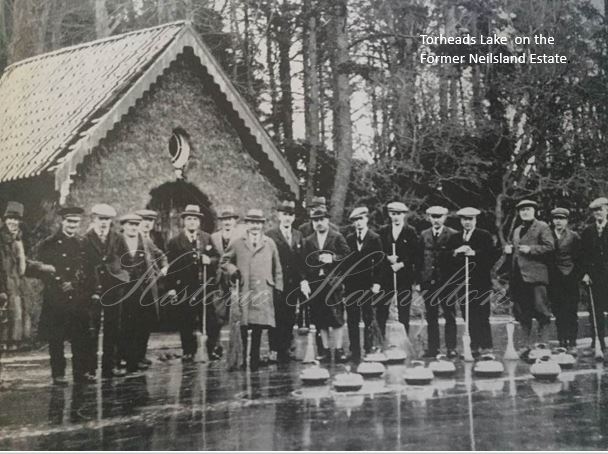
The large lands, once owned by the Watson family, stretched over 2000 acres all the way from Earnock past Torheads and down to Fairhill and Meikle Earnock and at Torheads, there is very little written about this part of Sir John Watson’s land. I wanted to tell you the story about the Torheads lake but when I started to research the lands of Torhead I thought that I would do this area of Hamilton some justice, and tell you about the people who once lived here.
Torheads Lake takes its name after Torheads Farm, which was a farm steading situated south of Hamilton Town Centre and the farmland stretched across 57 acres and it was surrounded by fields and woodland as far as the eye could see.
The first owner that I have found was a farmer called William Gardiner who was born on the sixteenth of September 1810, to parents William Gardiner Snr and Janet Hart. William Gardiner who from 1841, owned the farm and he lived here with his wife Margaret Wilson and their nine children who were called William, Janet, Margaret, John, Jane, Andrew, James, Robert and Bethia.
It seems that William was an outgoing social person, who liked to take part in things within his community. One thing that he always took part in was the local Annual Ploughing matches, where in February 1849, he judged a Ploughing Match in Hamilton and later on in 1856, he appears in the Glasgow Hearld as coming in 4th place in a ploughing competition where the Duke of Hamilton was in attendance handing out medals to the winners on this day.
William Gardiner had owned Torheads from at least 1841 up until 1863, where things seem to take a turn for the worse for William as in April 1863, he files for Bankruptcy and he loses his Farm at Torheads. At the age of 53, poor William after working at the farm his whole life is left with nothing. Torheads Farm was later overseen by the Heirs of D. Marshall Esq and was factored by Thomas Dykes of Hamilton. After 1863, the trail goes cold and I can’t find any further info on what became of William and his family.

Moving on, the next family that I found living at Torheads was the Wilson Family. In 1865, the farm steading was leased to John Wilson who was a man from Avondale in Lanarkshire and he took over Torheads and became the new tenant farmer.
John Wilson who was married to Elizabeth Blackwood leased Torheads from 1865, up until his death 17th May 1884. In the time that John and his wife Elizabeth lived on the farm, they had six children born at Torheads who were John, James, Elizabeth, Ellen, Robert & Euphemina.
As Sir John Watson started to extend his coal mining empire, he snapped up all of the land and properties around Midstonehall and Earnock, which began with the purchase of the Midstonehall Estate in April 1871. Sir John Watson wanting to put his own stamp on Midstonehall House then changed it’s name to Neilston House taking the name from a nearby Farm Steading which was to be then locally known as the Old Neilston House.

Sir John Watson moved on and extended his land portfolio and bought the land at Torheads and in the year 1873, he arranged for a water supply pipe to be run from Neisland Mansion House to the Torheads marshy land which surrounded Torheads Farm at this time. The area was formerly known as the “Tally Ho” and it was transformed into a small lake. When the lake was constructed, a varied selection of trees were planted to form an arboretum on both sides of the glen and a rockery was also created to give it a much grander appearance.
I have to mention that the name “Tally Ho” could possibly have been used in reference to a hunting ground, but this is just my thoughts on it. The Tor Lake was more than likely designed by a Dundee man named David Mitchell, who was a former gardener of the Duke of Hamilton. David Mitchell had also helped build the beautiful gardens at the Grand Neilsland House.
In the year 1895, a man named Robert Maxwell, who was a road foreman, is now living at Torheads and renting from Sir John Watson. As Robert was a foreman, I would say that the house at Torheads was a ‘Perk of the Job’ house. Robert Maxwell, even though was living in the farmhouse and as I stated, was not a farmer, he was a Foreman and did not seem to have lived here for long, as only 10 years later the land at Torheads, is being used once again as a working farm. Robert Nisbet who was a Dairyman is now the tenant farmer and running Torheads as a milk dairy. He is now leasing part of Torheads from the Watsons and once more this tenancy is a short one as Robert died of heart failure at the age of 47, on the 21st of November 1908.
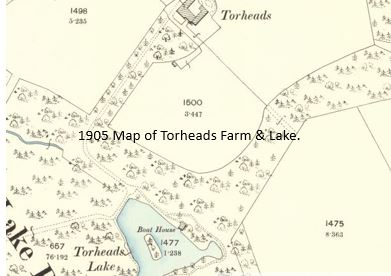
After the death of Robert Nisbet, the farm is partly leased – yet again from the Watson’s and it was a cow feeder who went by the name of Alexander Baird, who was now overseeing Torhead Farm. Now, I know that a lot of you can relate to the name Baird as they have been a long established family of milkmen in the town.
The Bairds worked on Torheads farm from around 1910, and I have traced this family still living here in 1930, where around this time the lease seems to change hands and there is now a man named Alexander Robertson who also seems to be involved in the farm. The Bairds in Hamilton are still to this day a family of milkmen, they have Dairies in High Patrick Street, Portland Place and I believe that they have farms around the Muttonhole Road area.
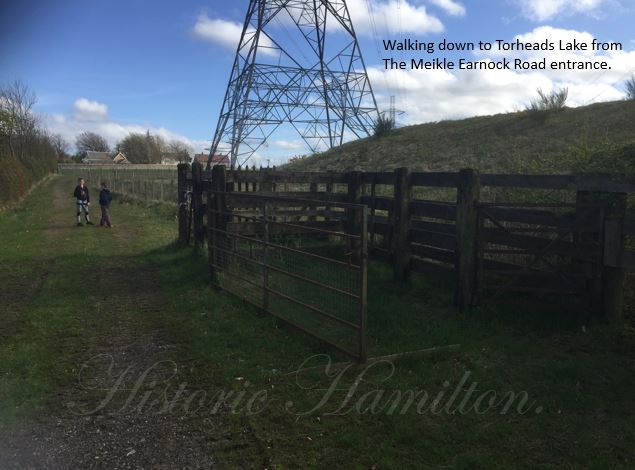
I have still got much research to do on Torheads Farm and Lake and I will probably update this story for Historic Hamilton when I gather more information on it. On Sunday the 23rd of April 2017 I visited the swampy marshy land with my two sons Daniel and Ryan and as we approached the field we were greeted by two big deer, which unbeknown to us were standing watching as we walked past.
When we got as close as about 200 yards they bolted and both jumped over a big high metal fence to get away and I don’t know who got the biggest fright, them or us.

As we approached what was once called the Taly Ho and walked down through the fields and eventually reached old Torhead Lake I was trying to imagine the fun that the Watson’s would have had when they were entertaining their guests with a game of curling. We only managed to get as far as the edge of the lake but it was a hard obstacle to tackle as the overgrown hedges and trees stopped us from going straight through. This area has now been left to mother nature.
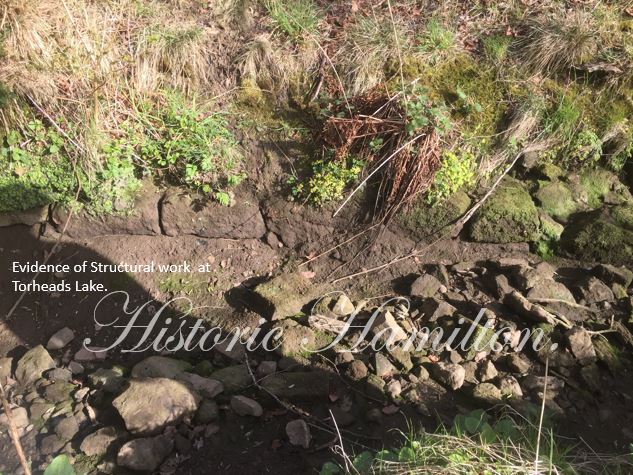
When I went on my trip to Torhead Lake, I was trying to find if there was still evidence of the Boat House that was seen in the picture of the Watson’s curling on the Lake. I never got as deep into the swamp as I would have liked to, but this will be another adventure for another day.
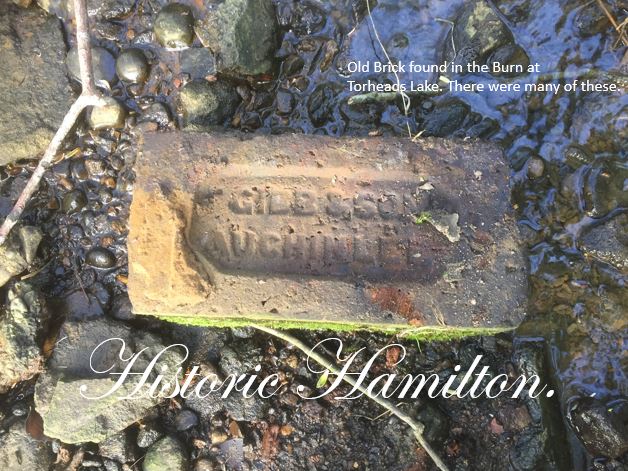
I would like to ask our readers who live in Pembury Crescent – have you noticed any evidence of brickwork through the dense overgrown trees? For those of you who didn’t know, if you live in the row of houses from 17 to 37, where your back garden looks onto trees, you face the old Torheads Lake.

Loved that info amazing the history around us that we miss out on thank you
Sent from my iPhone
>
LikeLiked by 1 person
Great article.
We used to live on that stretch of Pembury Crescent, but I don’t remember finding any bricks when we excavated a chunk of our sloping garden back in 2005/6.
One thing that members of our family and also some of our neighbours noticed was a feeling that our houses could at times feel very crowded, as if the area had once been used for large gatherings and some kind of residual spirit lingered.
I know, it sounds like we’re all bampots, but it came up a few times in the seven years we lived there.
LikeLiked by 1 person
That whole area was a place of pleasure for the Watsons and not to mention the coal miners who passed this area going to and from work. Secondly the whole area has been farmed for many years.
Thanks for your post.
LikeLike
Reblogged this on Historic Hamilton.
LikeLike